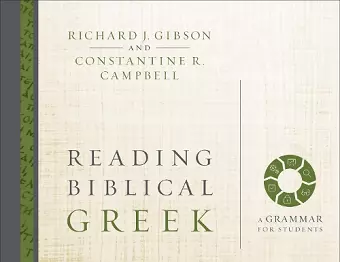Reading Biblical Greek
A Grammar for Students
Constantine R Campbell author Richard J Gibson author
Format:Hardback
Publisher:Zondervan
Published:23rd Mar '17
Currently unavailable, and unfortunately no date known when it will be back

An interesting and innovative approach to biblical Greek, providing a nice balance of theory, memorization, and practical exercises. This is one of the first introductory Greek grammars to introduce more nuanced theories of verbal aspect and the middle voice for the beginning student. -- Mark L. Strauss, Professor of New Testament, Bethel Seminary San Diego Con Campbell and Richard Gibson are to be congratulated for writing an introduction to biblical Greek that is informed by the latest studies in biblical linguistics and yet is accessible and user-friendly for instructors and students alike. This is not a fast-food-style crash course on Greek, nor a Greek grammar for budding scholars of classical antiquity. Rather, it is a book designed to teach you how to competently read the Greek text of the New Testament. Campbell and Gibson's Reading Biblical Greek is sure to become the standard introduction to Greek grammar in seminaries and colleges across the world. -- Michael F. Bird, lecturer in theology, Ridley College, Melbourne, Australia Open this book to any page, and you will feel that a master teacher (i.e., Campbell or Gibson) is gently leading you to abundant pastures of reading the Greek New Testament. Students will love this book. Well done! -- Robert L. Plummer, professor of New Testament interpretation, The Southern Baptist Theological Seminary Con Campbell and Richard Gibson's introductory Greek grammar and companion workbook reading Mark 1 - 4 will benefit beginning students greatly. As experienced and creative teachers they present key topics in bite-sized pieces with clear explanations and examples and good exercises to help students solidify their learning. The book's innovative three-column layout is visually helpful in distinguishing learning grammar, examples, and vocabulary. They draw well on recent studies of the Greek verb to make this book up-to-date. The focus on Mark 1 - 4 for examples and translation will encourage students as they see that they can read the New Testament in Greek for themselves. Bravo! -- Steve Walton, professorial research fellow in New Testament, St Mary's University, Twickenham, UK
Reading Biblical Greek is designed around three core elements: grammar, vocabulary, and reading and translation. It introduces first-year students to the essential information needed to optimize their grasp of the fundamentals of biblical Greek---no more and no less---enabling them to read and translate the Greek of the New Testament as soon as possible.
Reading Biblical Greek introduces first-year Greek students to the essential information needed to optimize their grasp of the fundamentals of the Greek language—no more and no less—enabling them to read and translate the Greek of the New Testament as soon as possible.
The learning approach in Reading Biblical Greek revolves around three core elements: grammar, vocabulary, and reading & translation.
- Grammar. The grammar consists of micro-lessons, which break up information in small, digestible chunks. Each micro-lesson addresses a single point. This arrangement makes for easy comprehension and review. It also allows the teacher to pace the material based on its difficulty and ability of their students. New learning is incremental and recursive—each new piece builds on and reinforces prior learning. Lessons are structured in three columns: 1) Introducing new topic; 2) Material to be memorized; and 3) Examples and exercises.
- Vocabulary. As an essential complement to grammar, vocabulary is introduced at strategic points and is arranged first by what the student has been learning in grammar, and then by frequency. The vocabulary lists are collated at the back of the book for easy access. The first 13 vocabulary lists are keyed to Mark 1-4 to help students to integrate their vocabulary learning with a “real” Greek text.
- Reading & Translation. The goal of this grammar is to enable students to read and translate the Greek of the New Testament. Thus, the content is structured and tied to a specific Greek text to enable reading as soon as possible. The student will have read and translated the whole of Mark 1–4 by the end of the course. The accompanying Reading Biblical GreekWorkbook is a vital part of the approach. It breaks up the text of Mark 1–4 into manageable portions and provides vocabulary and grammatical assistance as required.
While Reading Biblical Greek only introduces students to information that is essential to grasp of the fundamentals of the Greek language, it is informed by the latest and best...
ISBN: 9780310527992
Dimensions: 286mm x 222mm x 15mm
Weight: 634g
144 pages